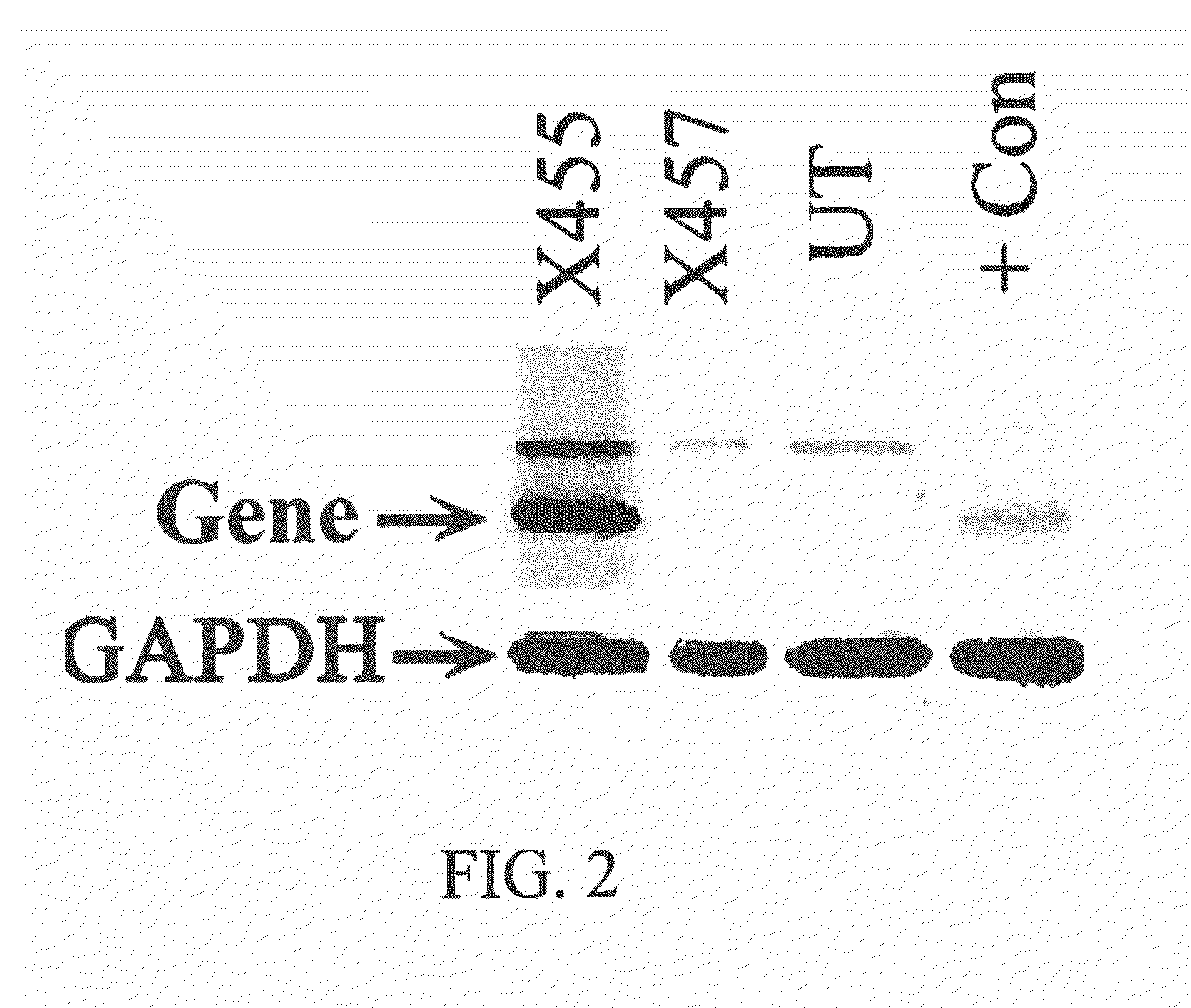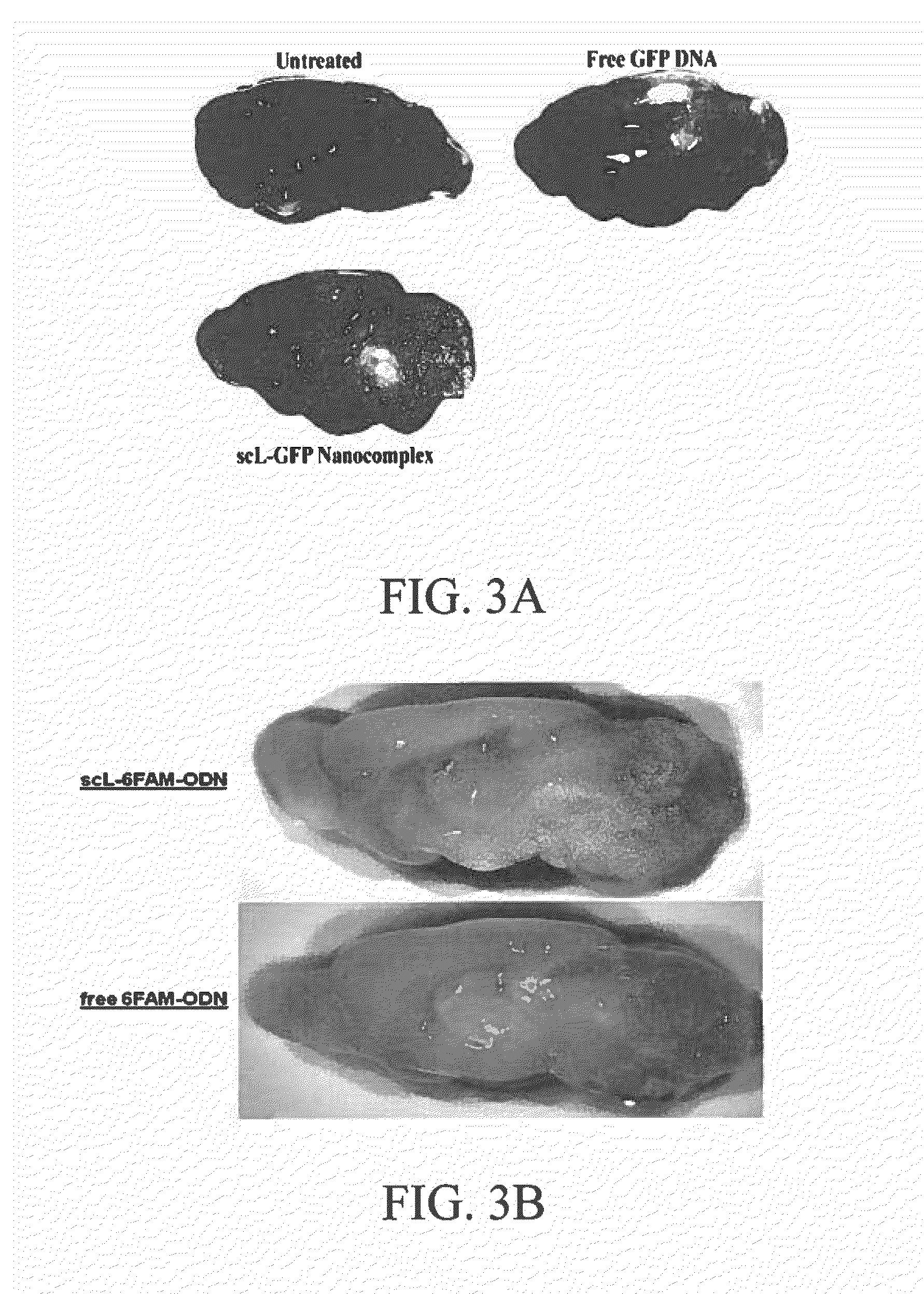Treatment for exposure to nerve agent
a nerve agent and treatment technology, applied in the field of nerve agent treatment, can solve the problems of pns cholinergic hyperstimulation, death, and even small amount of exposure, and achieve the effect of preventing toxicity
- Summary
- Abstract
- Description
- Claims
- Application Information
AI Technical Summary
Benefits of technology
Problems solved by technology
Method used
Image
Examples
example 1
Presence of Transgene (Exogenous p53) in Metastatic Tumors from Subjects in a Phase I Clinical Trial of scL Delivered wtp53 Gene
[0131]This example demonstrates a successful transgene delivered by the scL nanocomplex (a liposome composition of the present invention comprising total nucleic acid, lipid and the single chain antibody TfscFv at a weight ratio of about 1:10:0.33 (μg total nucleic acid:μg lipid:μg single chain antibody) (also referred to herein as scL), encoding exogenous wtp53 DNA, SGT-53, is present in the tumors of treated patients. To assess tumor delivery of SGT-53, DNA PCR was performed to determine the exogenous p53 gene delivered by the SGT-53 complex in the tumors from subjects in an open label, single center, sequential dose escalating, Phase I study evaluating the safety, pharmacokinetics, and potential activity of SGT-53 in subjects with solid tumors and who had been offered all standard or approved therapies. The doses of SGT-53 administered to the subjects es...
example 2
Increase in Protein Expression after Cloning into the pSCMV Vector
[0132]The increase in protein expression as a result of placing a gene under the control a high expression promoter, as disclosed herein, is shown in FIG. 2. Human cells were transfected with scL (prepared as described below in Example 7) carrying a gene cloned into the pSCMV vector, or in the original construct. Twenty-four hours post-transfection, expression of the specific gene was assessed by Western analysis. The purified protein expressed from this specific gene is included on the gel as a positive control and for verification of protein positioning. An at least 10 fold higher level of the specific protein expression was observed with the pSCMV clone (X455) compared to that of the original construct (X457) which uses a standard promoter (FIG. 2). The specific band is present in X457 upon longer exposure (data not shown). GAPDH levels demonstrate equal protein loading. UT=untreated cells; +Con=purified protein to...
example 3
Ability of the scL Liposome Complex to Cross the Blood-Brain Barrier and Target Neuronal Cells
[0133]The ability to cross the blood-brain barrier and target neuronal cells in the brain is shown in FIGS. 3 and 4. In FIG. 3, Balb / C mice were injected with scL carrying either the pSCMV high expression plasmid containing the GFP gene (FIG. 3A) or carrying a fluorescently labeled oligonucleotide (6-FAM-ODN) (FIG. 3B) prepared as described below in Example 7. 24 or 48 hours later the brains were excised and imaged using the Maestro® In Vivo Imaging System (Perkin Elmer). In both cases, a significantly higher level of accumulation of the fluorescence signal is observed in the brains of the mice injected with the scL-delivered payload when compared to the level of accumulation / signal with either Free (unencapsulated) GFP DNA or Free (unencapsulated) 6-FAM-ODN.
[0134]The ligand-liposome complex targeting the TfR and carrying a plasmid encoding GFP (100 μg cDNA) prepared as described below in E...
PUM
| Property | Measurement | Unit |
|---|---|---|
| Time | aaaaa | aaaaa |
| Time | aaaaa | aaaaa |
| Mass | aaaaa | aaaaa |
Abstract
Description
Claims
Application Information
 Login to View More
Login to View More - R&D
- Intellectual Property
- Life Sciences
- Materials
- Tech Scout
- Unparalleled Data Quality
- Higher Quality Content
- 60% Fewer Hallucinations
Browse by: Latest US Patents, China's latest patents, Technical Efficacy Thesaurus, Application Domain, Technology Topic, Popular Technical Reports.
© 2025 PatSnap. All rights reserved.Legal|Privacy policy|Modern Slavery Act Transparency Statement|Sitemap|About US| Contact US: help@patsnap.com



